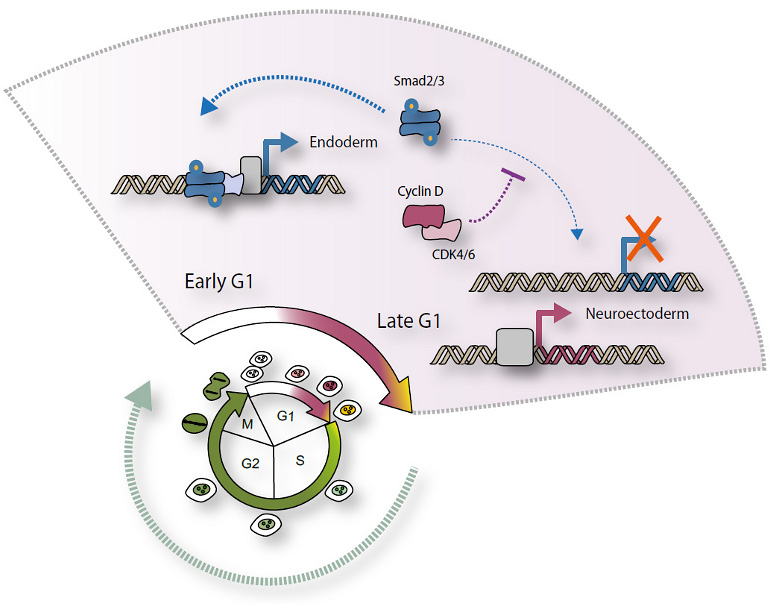When does a cell decide which direction to take?

Now, researchers describe for the first time the switches that determine how stem cells make that crucial decision. Their work might enable stem cells to be converted into a range of adult tissues more efficiently and more homogeneously.
Pluripotent stem cells have the potential to become any cell in the body. Interest in them has grown with the hope that they might be used to replace dying or damaged cells with healthy cells. Repairing tissues would be important in organ regeneration, bone repair and treatment of neurodegenerative diseases.
The team looked at the activity of key genes and proteins during the cell cycle – the processes by which a cell divides – in human pluripotent stem cells. They found that the molecular decision to continue to divide or to differentiate – to commit to a pathway towards a defined tissue type – is made during a restricted phase of the cell cycle.
“We know that cell division and differentiation need to be interconnected, but the mechanisms involved are yet to be uncovered. For the first time, we have a glimpse of how these two processes are biologically linked.”
“We have found key regulators of this process and have new methods that could more efficiently produce cell types with a clinical interest from human pluripotent stem cells.”
Dr Ludovic Vallier Lead author from the Wellcome Trust Sanger Institute and the University of Cambridge
They looked at the times during the cell cycle that the stem cell could commit to specific lineages, including liver and pancreas. They found that the decision could be made only at certain stages of the cell cycle and that the timing of the decision could drive the cell down different pathways.
This potential synchronisation of stem cells could result in new methods to generate specific cell types for regenerative medicine.
The team showed that these cell-cycle restricted decisions are influenced by a group of proteins known as cyclin Ds. The activity of these proteins, which control cell cycle progression, only direct the differentiation of human embroyonic stem cells toward specific lineages by controlling external stimuli. It is possible that the cyclin D mechanisms the team found in human stem cells work in a similar way during the development of human organs and in the natural repair or regrowth of tissues in adults.
The researchers also found that they could use a simple chemical compound, rather than a protein, to drive the stem cells towards tissues such as the liver. Modifying the activity of cell cycle regulators with simpler chemical treatments could make stem cell differentiation more efficient in the future.
“We have to uncover the biological secrets of stem cell biology to realise fully their value. This work helps us to understand how a stem cell makes a key decision – whether to divide and remain a stem cell, or to enter on a pathway to contributing to tissue, as we would require for regenerative medicine.
“With this knowledge, Dr Vallier and his colleagues will be able to refine the methods that help stem cells to become, for example, pancreas or liver cells.”
Professor Mike Stratton Director of the Wellcome Trust Sanger Institute
More information
Funding
The work was funded by Medical Research Council and the Cambridge Hospitals National Institute for Health Research Biomedical Research Center.
Participating Centres
- Wellcome Trust-Medical Research Council Cambridge Stem Cell Institute, Laboratory for Regenerative Medicine and Department of Surgery, University of Cambridge, Cambridge, UK
- Wellcome Trust Sanger Institute, Hinxton, Cambridge, UK
Publications:
Selected websites
Medical Research Council
For almost 100 years the Medical Research Council has improved the health of people in the UK and around the world by supporting the highest quality science. The MRC invests in world-class scientists. It has produced 29 Nobel Prize winners and sustains a flourishing environment for internationally recognised research. The MRC focuses on making an impact and provides the financial muscle and scientific expertise behind medical breakthroughs, including one of the first antibiotics penicillin, the structure of DNA and the lethal link between smoking and cancer. Today MRC funded scientists tackle research into the major health challenges of the 21st century.
The Wellcome Trust Sanger Institute
The Wellcome Trust Sanger Institute is one of the world’s leading genome centres. Through its ability to conduct research at scale, it is able to engage in bold and long-term exploratory projects that are designed to influence and empower medical science globally. Institute research findings, generated through its own research programmes and through its leading role in international consortia, are being used to develop new diagnostics and treatments for human disease.
The Wellcome Trust
The Wellcome Trust is a global charitable foundation dedicated to achieving extraordinary improvements in human and animal health. We support the brightest minds in biomedical research and the medical humanities. Our breadth of support includes public engagement, education and the application of research to improve health. We are independent of both political and commercial interests.


